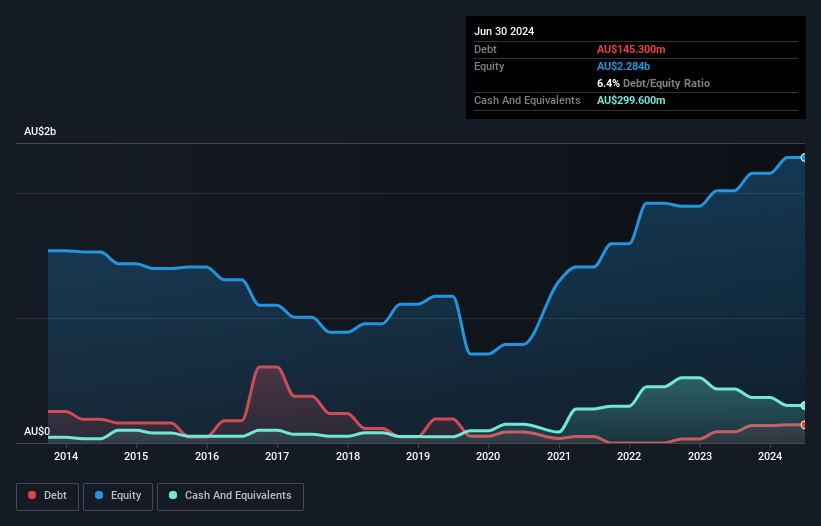- Australia
- /
- Metals and Mining
- /
- ASX:ILU
These 4 Measures Indicate That Iluka Resources (ASX:ILU) Is Using Debt Extensively
Warren Buffett famously said, 'Volatility is far from synonymous with risk.' So it seems the smart money knows that debt - which is usually involved in bankruptcies - is a very important factor, when you assess how risky a company is. As with many other companies Iluka Resources Limited (ASX:ILU) makes use of debt. But the more important question is: how much risk is that debt creating?
Why Does Debt Bring Risk?
Debt assists a business until the business has trouble paying it off, either with new capital or with free cash flow. Part and parcel of capitalism is the process of 'creative destruction' where failed businesses are mercilessly liquidated by their bankers. However, a more usual (but still expensive) situation is where a company must dilute shareholders at a cheap share price simply to get debt under control. Of course, the upside of debt is that it often represents cheap capital, especially when it replaces dilution in a company with the ability to reinvest at high rates of return. When we examine debt levels, we first consider both cash and debt levels, together.
See our latest analysis for Iluka Resources
How Much Debt Does Iluka Resources Carry?
The image below, which you can click on for greater detail, shows that at June 2024 Iluka Resources had debt of AU$145.3m, up from AU$89.2m in one year. However, it does have AU$299.6m in cash offsetting this, leading to net cash of AU$154.3m.

How Strong Is Iluka Resources' Balance Sheet?
Zooming in on the latest balance sheet data, we can see that Iluka Resources had liabilities of AU$270.1m due within 12 months and liabilities of AU$897.3m due beyond that. Offsetting this, it had AU$299.6m in cash and AU$271.5m in receivables that were due within 12 months. So it has liabilities totalling AU$596.3m more than its cash and near-term receivables, combined.
Iluka Resources has a market capitalization of AU$2.49b, so it could very likely raise cash to ameliorate its balance sheet, if the need arose. However, it is still worthwhile taking a close look at its ability to pay off debt. While it does have liabilities worth noting, Iluka Resources also has more cash than debt, so we're pretty confident it can manage its debt safely.
In fact Iluka Resources's saving grace is its low debt levels, because its EBIT has tanked 40% in the last twelve months. When a company sees its earnings tank, it can sometimes find its relationships with its lenders turn sour. When analysing debt levels, the balance sheet is the obvious place to start. But ultimately the future profitability of the business will decide if Iluka Resources can strengthen its balance sheet over time. So if you want to see what the professionals think, you might find this free report on analyst profit forecasts to be interesting.
Finally, while the tax-man may adore accounting profits, lenders only accept cold hard cash. While Iluka Resources has net cash on its balance sheet, it's still worth taking a look at its ability to convert earnings before interest and tax (EBIT) to free cash flow, to help us understand how quickly it is building (or eroding) that cash balance. In the last three years, Iluka Resources created free cash flow amounting to 19% of its EBIT, an uninspiring performance. That limp level of cash conversion undermines its ability to manage and pay down debt.
Summing Up
While Iluka Resources does have more liabilities than liquid assets, it also has net cash of AU$154.3m. So although we see some areas for improvement, we're not too worried about Iluka Resources's balance sheet. The balance sheet is clearly the area to focus on when you are analysing debt. However, not all investment risk resides within the balance sheet - far from it. These risks can be hard to spot. Every company has them, and we've spotted 1 warning sign for Iluka Resources you should know about.
At the end of the day, it's often better to focus on companies that are free from net debt. You can access our special list of such companies (all with a track record of profit growth). It's free.
New: AI Stock Screener & Alerts
Our new AI Stock Screener scans the market every day to uncover opportunities.
• Dividend Powerhouses (3%+ Yield)
• Undervalued Small Caps with Insider Buying
• High growth Tech and AI Companies
Or build your own from over 50 metrics.
Have feedback on this article? Concerned about the content? Get in touch with us directly. Alternatively, email editorial-team (at) simplywallst.com.
This article by Simply Wall St is general in nature. We provide commentary based on historical data and analyst forecasts only using an unbiased methodology and our articles are not intended to be financial advice. It does not constitute a recommendation to buy or sell any stock, and does not take account of your objectives, or your financial situation. We aim to bring you long-term focused analysis driven by fundamental data. Note that our analysis may not factor in the latest price-sensitive company announcements or qualitative material. Simply Wall St has no position in any stocks mentioned.
About ASX:ILU
Iluka Resources
Engages in the exploration, project development, mining, processing, marketing, and rehabilitation of mineral sands in Australia, China, rest of Asia, Europe, the Americas, and internationally.
Undervalued with mediocre balance sheet.
Similar Companies
Market Insights
Community Narratives




